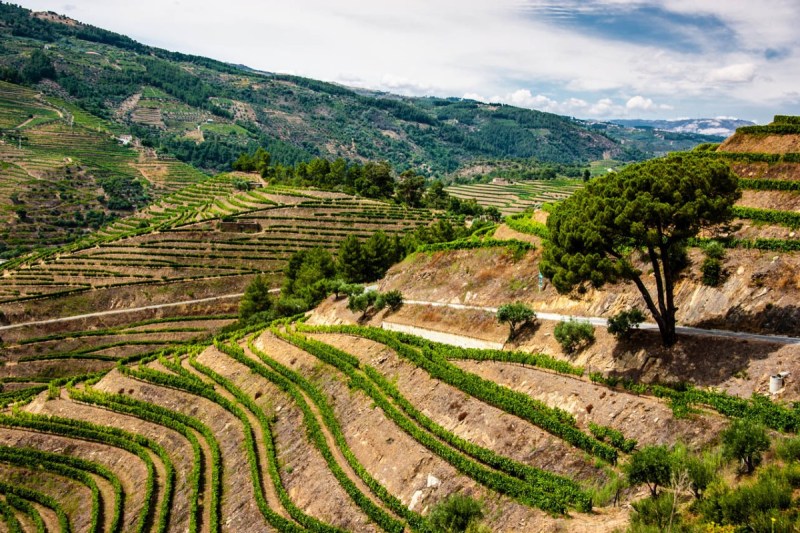As climate change unwinds, major sectors like agriculture are having to evolve. In wine, there’s been a move up to higher elevation vineyard sites in order to access the ideal climate for growing. That’s especially the case for delicate varietals like Pinot Noir that have pretty strict demands.
It turns out that there are many reasons for planting vineyards at higher elevations. Higher elevation sites have become or are becoming iconic, from the Mosel in Europe to high-set valleys in Argentina and Chile. With elevation, you get more than just thinner air and a narrower growing season. You get a plethora of details that can make for a wondrous wine.
This writer used to work in Willamette Valley wine country and was constantly amazed by how the same grape variety—same clone even—could behave so differently when planted at, say, 400 feet versus 800 feet. Higher-set grapes ripened a bit later, granted, but they often reflected the varying soil types through distinctive flavors and sometimes showed more balance and detail overall.

Derek Delfino knows about wine growing at elevation. He’s the owner and vineyard manager at Edio Vineyards in California. The label grows its grapes in the El Dorado American Viticulture Area (AVA), one of the highest in the West Coast wine scene. His highest site, Canavese Vineyard, rests about 3,000 feet above sea level.
“It was the first vineyard my Grandfather planted back in the ‘70s, which he planted to Cabernet Sauvignon,” Delfino said. “Cab Sauv is one of the varieties that best displays the benefits of the intense UV light.” That light, he says, is not only the result of the elevation, but it does wonders for the fruit. “The intense UV light we see at our elevation degrades pyrazines much faster and we do not find our wine is overly pyrazine forward or green, even with us picking early,” he said.
The benefits

About that UV light. It increases in concentration, which Delfino says produces thicker skins in the fruit and deeper color and tannin. “Another benefit would be our temperature shifts,” he continued. “We do see intense summer days, but at night, the temperature can shift significantly, which allows the grapes to preserve acidity and ultimately leads to a more elegant wine.”
That temperature swing is dubbed the diurnal shift, and it is a big deal in agriculture. “Finally, high-elevation vineyards are typically planted on steep slopes with varying topography and aspects,” he says. “This allows the vineyard manager to manipulate the vines to best fit the final style of wine coming from that block. The topography can also offer deep, well-drained soils that allows the vines to push their roots deep and these roots are never sitting in water due the rapid water drainage as a result of the steep topography.”
Those well-draining soils may prove all the more important as climate change makes for more extreme weather. Higher-set vineyards with good ventilation (wind) will prove all the more valuable as well, especially as winegrowers navigate the increasingly more intense wildfire season. And this is to say nothing of the perks of growing higher up away from others, where perhaps there’s greater access to biodiversity and the countless benefits of that kind of environment.
The challenges

“All the benefits of our high-elevation vineyards are double-edged swords,” Delfino said. “We deal with significant spring frosts in April and May, and we have lost up to 85% of our estate fruit in some years.” That’s a colossal figure and something no grape grower ever wishes for. “Also, sometimes the final berry ripening can bleed too much into the cold months where we see severe storms at the beginning of winter,” he adds.
The crucial spring and summer months leading to the harvest can also be condensed. “Our growing season can be much more narrow due to the intense winters we see and our cold springs,” he added. “In some years, we can see snow on our vineyard floor deep into April. This delays bud break significantly and can put us weeks if not months behind other growing regions.”
That shorter growing season can involve a longer ripening period, though. “When bud break is delayed, it leads to the final ripening period being delayed as well,” Delfino said. “So instead of ripening in the warmer months of August and September, our sites usually see the final stages of ripening in October and well into November. This gives us a more gradual sugar accumulation and more time for the berries to develop flavor. Flavor accumulation happens at the very end of berry ripening, and the longer a vineyard manager can draw out the period, the more flavorful the grapes will be.”
What does that slow and steady growth lead to in the glass? Balance. Detail. Distinction. Nuance. Resonance. All the things you hope for in a great pour of wine.
The future

“In my opinion, it will become more and more challenging to grow certain varieties in areas that are being severely affected by climate change,” Delfino admitted. “Wine grapes can be delicate and in some regions the climate is changing to a point where it may not be suited for certain varieties. Up at our elevation, we have not felt the effects as much, and climate change has not impacted our decision-making at all.”
Winemakers are already on the move, or at least looking ahead. Producers have pursued higher sites up and down the West Coast and beyond. In fact, some of the most up-and-coming regions tend to be higher-set, such as Colorado, Texas, and Arizona. Higher AVAs like the Chehalem Mountains in the Willamette Valley and Howell Mountain in California are becoming even more coveted.
Climate change unlocks new possibilities, too, like English sparkling wine. Places once deemed too cold for viticulture show promise as the world ag map remakes itself.
If wine is your thing, stay tuned to the drinks section of The Manual. In the meantime, check out our helpful wine terminology guide.



